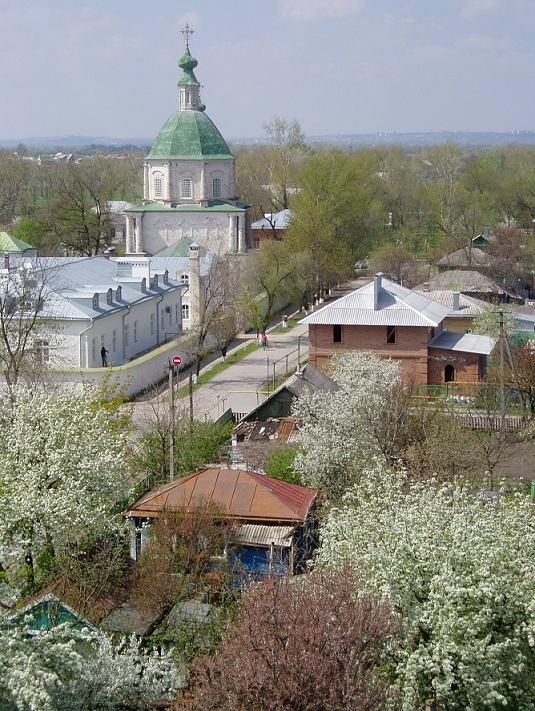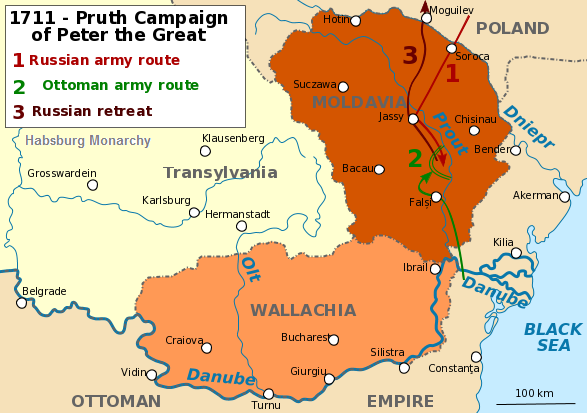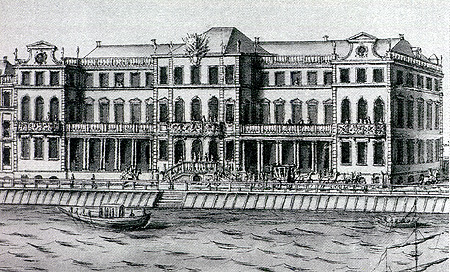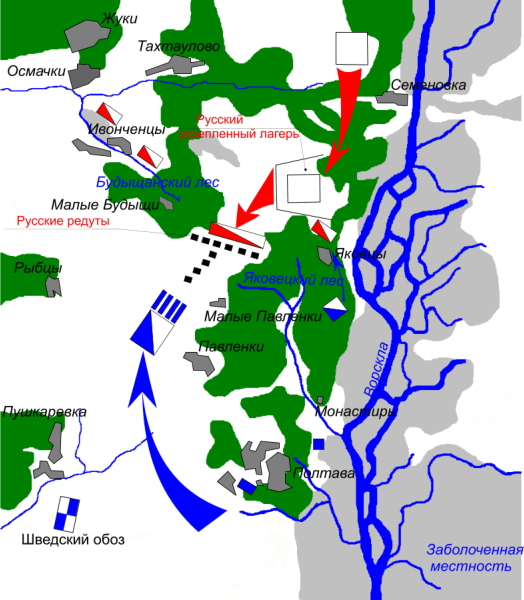|
Ivan Andreyevich Tolstoy
Ivan Andreevich Tolstoy (russian: Иван Андреевич Толстой) (1644–1713) was a Russian officer in the army of Tsar Peter I. Ivan Andreevich was a member of prominent Tolstoy family, son of Andrey Vasiliyevich Tolstoy and Solomonida Miloslavskaya, older brother of Pyotr Andreyevich Tolstoy, distant relation of Maria Miloslavskaya (first wife of tzar Aleksey Mikhailovich). The royal relations became very dangerous for brothers Tolstoys after Peter I took the power, as he hated his half-sister Sophia and distrusted all her Miloslavsky relatives. Despite this Peter respected the abilities of the Tolstoy brothers and allowed them to follow a military career: ''Ah head, head, were you not so clever I should have cut it off long ago'' - he actually said to Pyotr Tolstoy. In 1703 Ivan Tolstoy was appointed Governor of Azov - the fortress and naval base on the Black Sea that was critically important in the confrontation between Russia and Turkey, bands of Don Cossacks ... [...More Info...] [...Related Items...] OR: [Wikipedia] [Google] [Baidu] |
Peter I Of Russia
Peter I ( – ), most commonly known as Peter the Great,) or Pyotr Alekséyevich ( rus, Пётр Алексе́евич, p=ˈpʲɵtr ɐlʲɪˈksʲejɪvʲɪtɕ, , group=pron was a Russian monarch who ruled the Tsardom of Russia from to 1721 and subsequently the Russian Empire until his death in 1725, jointly ruling with his elder half-brother, Ivan V until 1696. He is primarily credited with the modernisation of the country, transforming it into a European power. Through a number of successful wars, he captured ports at Azov and the Baltic Sea, laying the groundwork for the Imperial Russian Navy, ending uncontested Swedish supremacy in the Baltic and beginning the Tsardom's expansion into a much larger empire that became a major European power. He led a cultural revolution that replaced some of the traditionalist and medieval social and political systems with ones that were modern, scientific, Westernised and based on the Enlightenment. Peter's reforms had a lastin ... [...More Info...] [...Related Items...] OR: [Wikipedia] [Google] [Baidu] |
Kondraty Bulavin
The Bulavin Rebellion or Astrakhan Revolt (; Восстание Булавина, ''Vosstaniye Bulavina'') was a war which took place in the years 1707 and 1708 between the Don Cossacks and the Tsardom of Russia. Kondraty Bulavin, a democratically elected Ataman of the Don Cossacks, led the Cossack rebels. The conflict was triggered by a number of underlying tensions between the Moscow government under Peter I of Russia, the Cossacks, and Russian peasants fleeing from serfdom in Russia to gain freedom in the autonomous Don area. It started with the 1707 assassination of Prince , the leader of Imperial army's punitive expedition to the Don area, by Don Cossacks under Bulavin's command. The end of the rebellion came with Bulavin's death in 1708. Underlying causes A number of social grievances were prevalent in the peasant population of Russia in the years leading up to the Bulavin Rebellion. Peter the Great's radical reforms designed to "Westernize" old Muscovy in the 18th ... [...More Info...] [...Related Items...] OR: [Wikipedia] [Google] [Baidu] |
1713 Deaths
Events January–March * January 17 – Tuscarora War: Colonel James Moore leads the Carolina militia out of Albemarle County, North Carolina, in a second offensive against the Tuscarora. Heavy snows force the troops to take refuge in Fort Reading, on the Pamlico River. * February 1 – Skirmish at Bender, Moldova: Charles XII of Sweden is defeated by the Ottoman Empire. * February 4 – Tuscarora War: The Carolina militia under Colonel James Moore leaves Fort Reading, to continue the campaign against the Tuscarora. * February 25 – Frederick William I of Prussia begins his reign. * March 1 – Tuscarora War: Colonel James Moore's Carolina militia lays siege to the Tuscaroran stronghold of Fort Neoheroka, located a few miles up Contentnea Creek from Fort Hancock. * March 20 – Tuscarora War: Colonel James Moore's Carolina militia launches a major offensive against Fort Neoheroka. * March 23 – Tuscarora War: Fort Neoheroka falls to the ... [...More Info...] [...Related Items...] OR: [Wikipedia] [Google] [Baidu] |
1644 Births
It is one of eight years (CE) to contain each Roman numeral once (1000(M)+500(D)+100(C)+(-10(X)+50(L))+(-1(I)+5(V)) = 1644). Events January–March * January 22 – The Royalist Oxford Parliament is first assembled by King Charles I of England. * January 26 – First English Civil War – Battle of Nantwich: The Parliamentarians defeat the Royalists, allowing them to end the 6-week Siege of Nantwich in Cheshire, England. * January 30 – **Dutch explorer Abel Tasman departs from Batavia in the Dutch East Indies (now Jakarta in Indonesia) on his second major expedition for the Dutch East India Company, to maps the north coast of Australia. Tasman commands three ships, ''Limmen'', ''Zeemeeuw'' and ''Braek'', and returns to Batavia on August 4 with no major finds. ** Battle of Ochmatów: Polish–Lithuanian Commonwealth forces under hetman Stanisław Koniecpolski secure a substantial victory over the horde of Crimean Tatars, under Tugay B ... [...More Info...] [...Related Items...] OR: [Wikipedia] [Google] [Baidu] |
Cherkassk
Starocherkasskaya (russian: Старочерка́сская), formerly Cherkassk (), is a rural locality (a ''stanitsa'') in Aksaysky District of Rostov Oblast, Russia, with origins dating from the late 16th century. It is located on the right bank of the Don River approximately upstream from the major Russian port city of Rostov-on-Don. It is famous for having been the center of Don Cossack culture and politics for nearly two centuries as the capital of the Don Host Oblast. Due to regular spring floods that submerged the small city on several occasions, the Cossacks moved their capital to higher ground at Novocherkassk in 1805. In and around Starocherkasskaya there are over forty noteworthy historical and cultural sites including the Resurrection (Voskresensky) Cathedral, completed in 1719, and its famous gilded wooden iconostasis. History A Cossack fortress on the island of what was later called ''Monastyrsky'' on the Don river was probably built before 1570 although it is ... [...More Info...] [...Related Items...] OR: [Wikipedia] [Google] [Baidu] |
Pruth Campaign
The Russo-Ottoman War of 1710—1711, also known as the Pruth River Campaign, was a brief military conflict between the Tsardom of Russia and the Ottoman Empire. The main battle took place during 18-22 July 1711 in the basin of the Pruth river near Stănilești (Stanilesti) after Tsar Peter I entered the Ottoman vassal Principality of Moldavia, following the Ottoman Empire’s declaration of war on Russia. The ill-prepared 38,000 Russians with 5,000 Moldavians, found themselves surrounded by 200,000 Turks under Grand Vizier Baltaci Mehmet Pasha. After three days of fighting and heavy casualties the Tsar and his armies were allowed to withdraw after agreeing to abandon the fortress of Azov and its surrounding territory. The Ottoman victory led to the Treaty of the Pruth which was confirmed by the Treaty of Adrianople. Background The Russo-Ottoman War of 1710-1711 broke out as a result of the Great Northern War, which pitted the Swedish Empire of King Charles XII of Sweden ... [...More Info...] [...Related Items...] OR: [Wikipedia] [Google] [Baidu] |
Fyodor Apraksin
Count Fyodor Matveyevich Apraksin (also ''Apraxin''; russian: Фёдор Матве́евич Апра́ксин; 27 October 1661 10 November 1728, Moscow) was one of the first Russian admirals, governed Estonia and Karelia from 1712 to 1723, was made general admiral (1708), presided over the Russian Admiralty from 1718 and commanded the Baltic Fleet from 1723. Early shipbuilding activities The Apraksin brothers were launched to prominence after the marriage of their sister Marfa to ''Tsar'' Feodor III of Russia in 1681. Fyodor entered the service of his brother-in-law at the age of 10 as a ''stolnik''. After Feodor's death he served the little ''tsar'' Peter in the same capacity. He took part in military amusements of the young ''tsar'' and helped to build a toy flotilla for him. The playfellowship of the two lads resulted in a lifelong friendship. In 1692 Apraksin was appointed governor of Arkhangelsk, the foremost trade port of Russia at that time, and built ships capable of ... [...More Info...] [...Related Items...] OR: [Wikipedia] [Google] [Baidu] |
Battle Of Poltava
The Battle of Poltava; russian: Полта́вская би́тва; uk, Полта́вська би́тва (8 July 1709) was the decisive and largest battle of the Great Northern War. A Russian army under the command of Tsar Peter I defeated a Swedish army, under the command of Carl Gustaf Rehnskiöld. The battle put an end to the status of the Swedish Empire as a European great power, as well as its eastbound expansion, and marked the beginning of Russian hegemony in Northern Europe. During the course of six years in the initial stages of the war, King Charles XII and the Swedish Empire had defeated almost all participants in the anti-Swedish coalition, which initially consisted of the Polish-Lithuanian Commonwealth, Denmark-Norway and the Tsardom of Russia. The latter under Tsar Peter I's rule was the only one still undefeated. Charles XII therefore chose to invade Russia in the autumn of 1707 and march towards Moscow with a large Swedish army. However, the campaign w ... [...More Info...] [...Related Items...] OR: [Wikipedia] [Google] [Baidu] |
Don Cossacks
Don Cossacks (russian: Донские казаки, Donskie kazaki) or Donians (russian: донцы, dontsy) are Cossacks who settled along the middle and lower Don. Historically, they lived within the former Don Cossack Host (russian: Донское казачье войско, translit=Donskoe kazache voysko, which was either an independent or an autonomous democratic republic in present-day Southern Russia and parts of the Donbas region, from the end of the 16th century until 1918. As of 1992, by presidential decree of the Russian Federation, Cossacks can be enrolled on a special register. A number of Cossack communities have been reconstituted to further Cossack cultural traditions, including those of the Don Cossack Host. Don Cossacks have had a rich military tradition - they played an important part in the historical development of the Russian Empire and participated in most of its major wars. Etymology The name Cossack ( ru , казак, translit = kazak; uk , к� ... [...More Info...] [...Related Items...] OR: [Wikipedia] [Google] [Baidu] |
Tolstoy
Count Lev Nikolayevich TolstoyTolstoy pronounced his first name as , which corresponds to the romanization ''Lyov''. () (; russian: link=no, Лев Николаевич Толстой,In Tolstoy's day, his name was written as in pre-reformed Russian. ; ), usually referred to in English as Leo Tolstoy, was a Russian writer who is regarded as one of the greatest authors of all time. He received nominations for the Nobel Prize in Literature every year from 1902 to 1906 and for the Nobel Peace Prize in 1901, 1902, and 1909; the fact that he never won is a major controversy. Born to an aristocratic Russian family in 1828, Tolstoy's notable works include the novels ''War and Peace'' (1869) and ''Anna Karenina'' (1878), often cited as pinnacles of realist fiction. He first achieved literary acclaim in his twenties with his semi-autobiographical trilogy, ''Childhood'', '' Boyhood'', and ''Youth'' (1852–1856), and '' Sevastopol Sketches'' (1855), based upon his experiences in t ... [...More Info...] [...Related Items...] OR: [Wikipedia] [Google] [Baidu] |
Turkey
Turkey ( tr, Türkiye ), officially the Republic of Türkiye ( tr, Türkiye Cumhuriyeti, links=no ), is a list of transcontinental countries, transcontinental country located mainly on the Anatolia, Anatolian Peninsula in Western Asia, with a East Thrace, small portion on the Balkans, Balkan Peninsula in Southeast Europe. It shares borders with the Black Sea to the north; Georgia (country), Georgia to the northeast; Armenia, Azerbaijan, and Iran to the east; Iraq to the southeast; Syria and the Mediterranean Sea to the south; the Aegean Sea to the west; and Greece and Bulgaria to the northwest. Cyprus is located off the south coast. Turkish people, Turks form the vast majority of the nation's population and Kurds are the largest minority. Ankara is Turkey's capital, while Istanbul is its list of largest cities and towns in Turkey, largest city and financial centre. One of the world's earliest permanently Settler, settled regions, present-day Turkey was home to important Neol ... [...More Info...] [...Related Items...] OR: [Wikipedia] [Google] [Baidu] |
Black Sea
The Black Sea is a marginal mediterranean sea of the Atlantic Ocean lying between Europe and Asia, east of the Balkans, south of the East European Plain, west of the Caucasus, and north of Anatolia. It is bounded by Bulgaria, Georgia, Romania, Russia, Turkey, and Ukraine. The Black Sea is supplied by major rivers, principally the Danube, Dnieper, and Don. Consequently, while six countries have a coastline on the sea, its drainage basin includes parts of 24 countries in Europe. The Black Sea covers (not including the Sea of Azov), has a maximum depth of , and a volume of . Most of its coasts ascend rapidly. These rises are the Pontic Mountains to the south, bar the southwest-facing peninsulas, the Caucasus Mountains to the east, and the Crimean Mountains to the mid-north. In the west, the coast is generally small floodplains below foothills such as the Strandzha; Cape Emine, a dwindling of the east end of the Balkan Mountains; and the Dobruja Plateau considerably farth ... [...More Info...] [...Related Items...] OR: [Wikipedia] [Google] [Baidu] |

.jpg)






